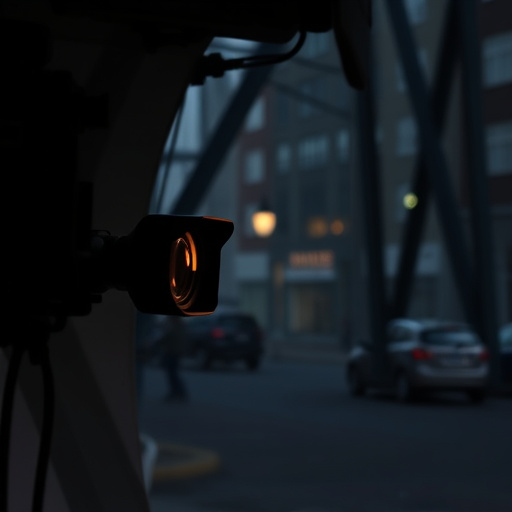Wireless Night Vision Security Cameras Indoors offer 24/7 clear image surveillance in low light. Essential features include high-res sensors, IR LED tech, and strategic placement for optimal coverage. Ethical use requires transparency, consent, and compliance with data protection laws like GDPR. Best practices for setup ensure reliable signal and camera positioning. Regular maintenance and troubleshooting ensure smooth operation.
“Uncover the power of enhanced indoor security with our comprehensive guide on professional covert monitoring systems. This article is your go-to resource for navigating the world of wireless night vision security cameras indoors. From understanding the basics to ethical considerations, we demystify camera selection and installation. Learn how to choose the right equipment, navigate legal privacy issues, and master efficient maintenance. Whether you’re a professional installer or a homeowner seeking peace of mind, this guide offers valuable insights for deploying covert Wireless Night Vision Security Cameras Indoors.”
- Understanding Wireless Night Vision Camera Basics
- Choosing Cameras for Optimal Indoor Coverage
- Ethical Considerations: Legal and Privacy Issues
- Professional Installation Tips and Best Practices
- Maintaining and Troubleshooting Your System Effectively
Understanding Wireless Night Vision Camera Basics
Wireless Night Vision Security Cameras Indoors have become a popular choice for home and business owners looking to enhance their security. These cameras leverage advanced technology to capture clear, low-light images using infrared (IR) illumination. The IR LEDs emit light invisible to the human eye but are detected by the camera’s sensor, allowing it to see in complete darkness. This feature makes them ideal for monitoring indoor spaces where natural light may be limited.
The basic components of a Wireless Night Vision Camera system include a camera unit, a receiver or base station, and a power source. The camera captures video and transmits it wirelessly to the receiver, which can then be viewed on a monitor or recorded for later review. Many modern systems offer features like motion detection, two-way audio, and cloud storage, making them versatile tools for various surveillance needs. Understanding these fundamentals is key to choosing and setting up an effective security system.
Choosing Cameras for Optimal Indoor Coverage
When selecting cameras for optimal indoor coverage, it’s crucial to prioritize wireless night vision security cameras indoors. These devices are designed to provide clear images even in low-light conditions, ensuring round-the-clock surveillance. Look for models that feature high-resolution sensors (like 1080p or higher) and IR LED technology for enhanced visibility in complete darkness.
Consider placement strategies such as strategic positioning near windows or common areas to maximize the camera’s field of view. Wireless connectivity also offers flexibility, allowing you to easily relocate cameras without extensive rewiring. Additionally, many modern indoor security cameras come with advanced features like motion detection and cloud storage, enhancing their effectiveness in monitoring various indoor environments.
Ethical Considerations: Legal and Privacy Issues
Implementing a covert monitoring system, particularly with wireless night vision security cameras indoors, raises significant ethical and legal questions that must be carefully navigated. The use of surveillance technology invades privacy and can foster a sense of unease among employees or residents. It’s crucial to adhere to relevant laws and regulations regarding data protection, such as GDPR in Europe, which govern how personal information is collected, stored, and used.
Professionals responsible for setting up such systems must ensure transparency and obtain consent where required by law. Employing wireless night vision security cameras indoors should be a last resort, only considered when other less intrusive methods have been exhausted. Clear policies outlining the purpose, scope, and limitations of surveillance must be in place to safeguard individual rights and maintain trust.
Professional Installation Tips and Best Practices
When setting up a covert monitoring system using wireless night vision security cameras indoors, professionals should adhere to best practices for optimal results. First, ensure all hardware components—cameras, receivers, and power supplies—are compatible and properly configured. Wireless cameras require robust signal strength; place access points strategically for seamless connectivity across the monitored area.
For maximum coverage, position cameras at strategic points, considering line-of-sight clearances to avoid obstructions. Regular maintenance is crucial; inspect cameras for any damage or debris buildup that could impede vision. Additionally, secure all connections to prevent interference from external sources, ensuring reliable and uninterrupted surveillance.
Maintaining and Troubleshooting Your System Effectively
Maintaining and troubleshooting your covert monitoring system, especially those employing wireless night vision security cameras indoors, requires a systematic approach. Regularly inspect each component for any signs of damage or malfunction. Cameras should be positioned optimally to capture clear footage without obstructions. Ensure power connections are secure and clean, as intermittent issues can disrupt camera functionality.
For troubleshooting, start with basic checks like verifying power supply and internet connectivity. Update firmware regularly to access the latest features and security patches. Keep an eye on storage space to avoid data overflow, which may lead to system failure. If issues persist, consult user manuals or reach out to technical support for guidance, ensuring your wireless night vision security cameras indoors operate seamlessly and effectively.
A well-installed wireless night vision security camera system indoors can significantly enhance home or business security, offering peace of mind and round-the-clock surveillance. By understanding camera basics, selecting the right equipment, adhering to ethical guidelines, implementing best installation practices, and maintaining proactive troubleshooting, you’ll ensure optimal performance and privacy protection. Remember, the right setup not only deters potential intruders but also acts as a valuable tool for quick response in case of emergencies.
